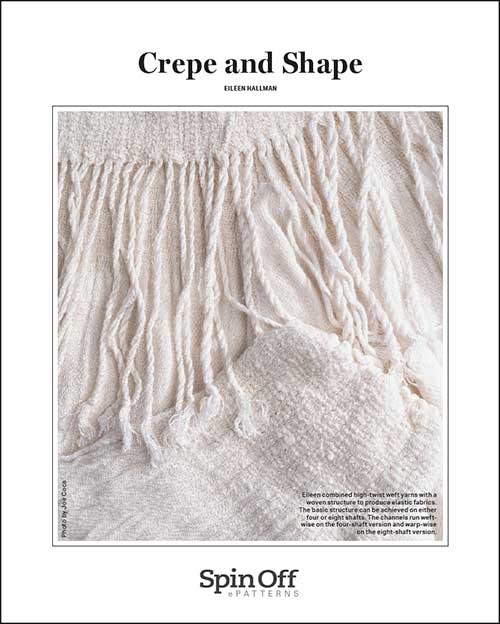Editor’s note: “Crêpe” can mean many things, but in this context, it refers to yarn with extra twist. For another version, crêpe-plied yarn, see “Soft Stripes: A Spinner’s Recipe for Self-Striping Yarn” from Spin Off Fall 2024.
What is a balanced yarn? We often refer to it as a yarn that hangs in a perfect loop after wet-finishing, and treat that as the ultimate spinning goal. In this scenario, overtwist is to be avoided at all costs.
Eileen Hallman thinks we’re looking at it all wrong. After all, twist is just stored energy. How energetic you want your yarn to be depends on your intended finished product. Borrowing from industrial spinning terminology, she points out that there are different categories of twist for different purposes. Knitting yarns require very little twist compared to weaving yarns. With each different category, the goal is to have just enough twist in the yarn to prevent it from breaking during the next stage of the manufacturing process, but still feel pleasant to the touch once it becomes fabric.
Even in the manufacturing world, there is a belief that yarn can have so much twist that it becomes unuseable. These yarns are often described as overtwisted, perhaps because they snarl in the machinery. This is where Hallman picks up the thread. By combining millspun warp and weft with her energetic handspun, she can create the best of both worlds.
 Spinning cotton on a charka. Eileen Hallman has long been an advocate for charka spinning and uses charka-spun singles to create dimension in her weaving. Photo from Spinning on a Charkha with Kate Larson
Spinning cotton on a charka. Eileen Hallman has long been an advocate for charka spinning and uses charka-spun singles to create dimension in her weaving. Photo from Spinning on a Charkha with Kate Larson
Try It and See
Many spinners avoid weaving with their handspun because it would take too much yarn, or because of the waste inherent in weaving. However, Hallman’s method minimizes waste by using commercial yarns in the warp and weft. Her precious energized handspun cotton singles are combined with a doubleweave structure to create a ribbing effect, much like knit and purl ribbing in knitting. Depending on the number of shafts used, this ribbing can be either horizontal or vertical.
The result: innovative garments that shape to the body with very little cutting and sewing. The entire outfit presented in Hallman’s Spin Off Fall 1999 article, “Crepe and Shape,” were made from a single warp, varying only the sequence of treadling and where she inserted her handspun yarn.
If we overlook our assumptions of what defines a good yarn, we can discover fascinating opportunities in these yarns that have extra energy. The possiblities are endless!
 Sections of ribbing are produced by combining the treadling sequence with energized handspun singles weft. Photo by Matt Graves
Sections of ribbing are produced by combining the treadling sequence with energized handspun singles weft. Photo by Matt Graves
Find the 1999 article in the Spin Off Library, which includes an updated draft and new photos of Eileen’s work, and a WIF file.
Crepe and Shape
by Eileen Hallman
Visit the Spin Off Library to read Eileen Hallman’s full article, “Crepe and Shape.”

Resources
- You can see an example of a crepe fabric in “Finnish Woven Waves: Hannele Köngäs Explores High-Twist Yarns”
- Dalgaard, Lotte and Adam, Paulette, trans. Ann Richards. Thread Magic: Weaving for Shape and Texture. Denmark: Forlaget Mellemvaerk, 2020.
- How to Spin on a Charkha with Kate Larson video course
Remember, as a subscriber, you have access to past issues of Spin Off cited in Hallman’s article, including:
Pamela K. Schultz is the content editor for Spin Off. She spins, weaves, knits, and gardens in coastal North Carolina.

